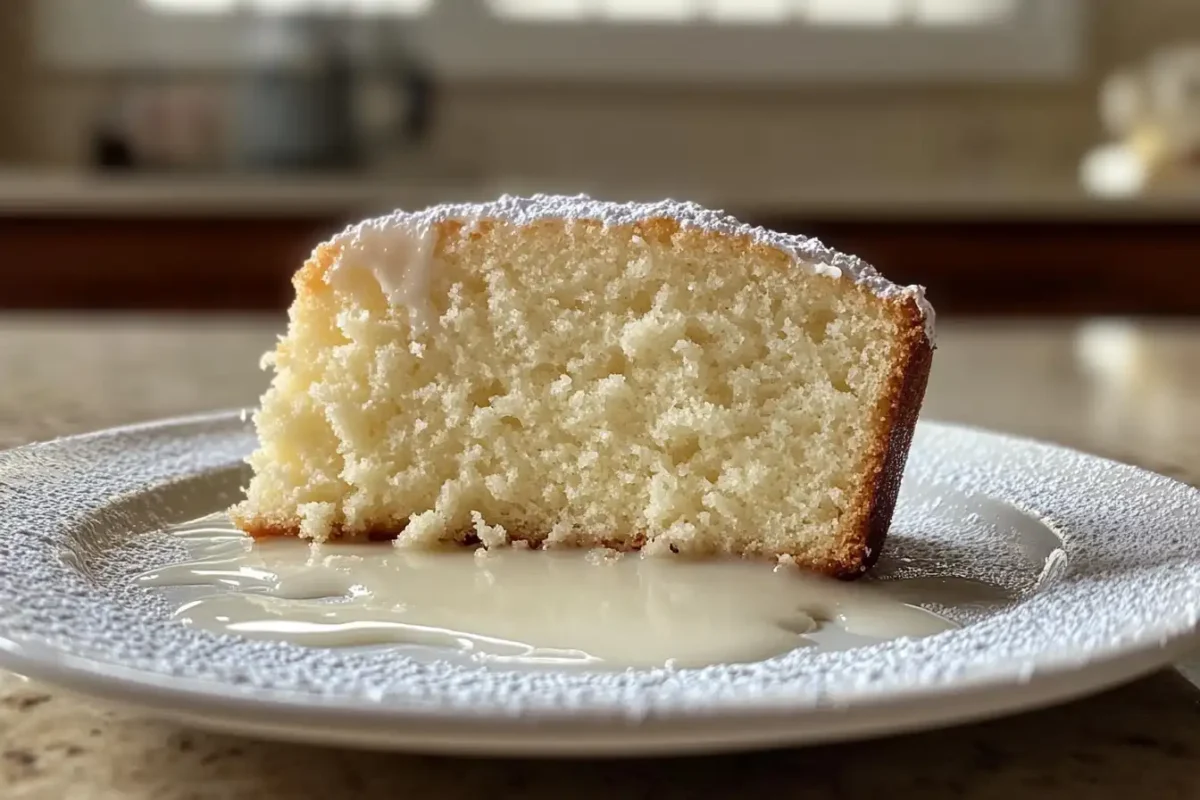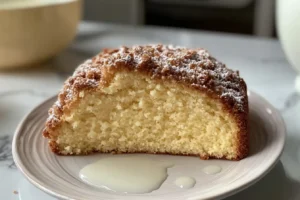Is milk or water better for pound cake? This article explores the impact of each liquid on the cake’s texture, taste, and overall quality. Learn which liquid yields the best results.
Milk vs. Water in Pound Cake: A Detailed Look
The choice between milk or water in a pound cake recipe can significantly alter the outcome. Therefore, understanding each liquid’s effect is crucial for baking success. We’ll explore how these ingredients influence the final texture, taste, and overall baking experience. Ultimately, the best choice depends on the desired characteristics of your cake. Consequently, making an informed choice can greatly enhance your baking endeavors.
If you’re considering creative recipes, such as those involving chocolate, you might find inspiration in this Chocolate Pound Cake Recipe.
The Role of Liquids in Baking
First, consider what liquids do in any baking recipe. Liquids activate gluten in flour, creating structure. They also help dissolve sugar and leavening agents. Consequently, the type of liquid used can impact the final product’s moisture, tenderness, and flavor. Therefore, making an informed decision is important. Furthermore, liquids affect the chemical reactions during baking, influencing both the texture and the taste.
Understanding the Effects of Milk
Milk, often a popular choice in baking, brings richness and flavor. Moreover, it contains fats and proteins that enhance the cake’s overall texture. Therefore, using milk typically results in a moister, more tender crumb. This added richness is also what makes the cake have a more complex flavor profile. Indeed, the sugars in the milk can promote better browning during baking. Accordingly, milk’s contribution goes beyond just moisture.
The Advantages of Milk in Pound Cake
-
Enhanced Flavor: The fats in milk add depth and richness, creating a more luxurious taste.
-
Moisture: Milk contributes to a moister crumb, preventing the cake from drying out and ensuring a pleasant mouthfeel.
-
Tender Texture: Milk proteins help create a more delicate and tender structure, enhancing the cake’s overall palatability.
-
Better Browning: The natural sugars in milk promote a beautiful golden crust, making the cake visually appealing.
-
Consequently, using milk can result in a pound cake with a more satisfying and indulgent texture and taste, suitable for various occasions.
Potential Drawbacks of Milk
-
Higher Fat: Milk’s fat content might make the cake heavier, which could be a concern for those seeking a lighter option.
-
Calorie Content: Using whole milk increases the cake’s calorie count, which might not align with everyone’s dietary goals.
-
Storage: Cakes with milk may not have the same shelf life as those made with water, requiring proper storage to maintain freshness.
-
Therefore, it is essential to consider these points when choosing between milk or water, balancing flavor and health considerations.
Understanding the Effects of Water
Water, a neutral liquid, does not add any flavor or fat to the recipe. However, it’s an essential part of activating the flour and keeping the cake moist. Thus, while it may not add extra flavor, water plays a key role in the baking process, facilitating gluten development and overall hydration. Therefore, understanding when to use it is key. Furthermore, water acts as a solvent, ensuring even distribution of other ingredients.
The Advantages of Water in Pound Cake
-
Clean Flavor: Water allows the other ingredients’ flavors to shine without interference, creating a less complex taste.
-
Light Texture: Using water often results in a lighter, less dense cake, which can be preferred for certain recipes.
-
Lower Fat: Water does not add fat, making it a good option for those seeking a lighter cake or those watching their calorie intake.
-
Longer Shelf Life: Cakes made with water can often have a slightly longer shelf life because there’s less fat to spoil.
-
Consequently, water is ideal if you prefer a simpler and less rich pound cake, highlighting the core flavors of other ingredients.
Potential Drawbacks of Water
-
Lack of Flavor: Water doesn’t add richness or complexity to the flavor profile, which could lead to a less interesting cake.
-
Drier Texture: Without added fats, the cake might be less moist, potentially resulting in a drier crumb.
-
Less Browning: Cakes made with water might not brown as deeply or evenly due to the absence of milk sugars, impacting visual appeal.
-
Therefore, the use of water should be carefully considered based on your desired outcome, potentially requiring adjustments to the recipe.
Is milk or water better for achieving specific pound cake results?
To answer the question, “is milk or water better for pound cake”? let’s delve into what each liquid is best suited for. If a richer flavor and moist texture are your priorities, then milk might be the better choice. However, if a lighter cake with clean flavors is desired, water is a better option. Therefore, the optimal choice often depends on personal preference. Ultimately, the decision is a balancing act between flavor, texture, and dietary considerations.
When to Choose Milk for Pound Cake
For a cake that’s moist and flavorful, choose milk. Milk’s fats and proteins add a depth of flavor that water simply can’t achieve. For example, cakes made with milk often have a finer crumb and richer taste. Consequently, it is an ideal choice for special occasions or when you want to impress. Moreover, the enhanced flavor and texture from milk often leave a more memorable impression.
Recipes Benefiting from Milk
-
Classic Pound Cakes: When a rich flavor and tender texture are the focus, milk is ideal, enhancing the traditional flavors.
-
Layer Cakes: The added moisture in milk helps keep the layers soft, preventing them from drying out.
-
Dessert Cakes: Milk makes the cake more dessert-like, with a creamy undertone, which is perfect for sweet indulgence.
-
Thus, for richer recipes, milk is the preferred choice, adding depth and character to the baked product.
When to Choose Water for Pound Cake
Water is best when you want a lighter, cleaner taste. For instance, if the pound cake is a base for a fruit topping or glaze, water can be ideal. Consequently, using water allows the other flavors to take center stage, creating a balanced taste profile. Therefore, it’s best for when you want a subtle taste and a less dense texture, allowing the other elements to shine.
Recipes Benefiting from Water
-
Fruit-Based Pound Cakes: Water lets fruit flavors shine without interference, providing a neutral base that doesn’t compete with other tastes.
-
Glazed Cakes: Water’s neutral base makes it easier to control the glaze flavors, preventing any unwanted flavors from interfering.
-
Simpler Pound Cakes: Water is great for a basic, less rich version of the cake, focusing on simplicity and ease of preparation.
-
Thus, if you need a lighter and neutral flavor base, water is the better option, highlighting the purity of the ingredients.
Milk or water and the effect on pound cake’s crumb
The crumb of a pound cake, referring to its interior texture, is significantly impacted by your choice of liquid. Milk tends to produce a finer, more tender crumb, thanks to its fat content. In contrast, water often leads to a slightly more open and less dense crumb, lacking the fat for the same effect. Therefore, understanding this difference is key when deciding which to use, as it affects the mouthfeel and overall enjoyment of the cake.
How Milk Affects the Crumb
The fats and proteins in milk contribute to a tighter, more delicate crumb. Moreover, this creates a velvety smooth texture, making each bite enjoyable. Indeed, the added fat also prevents the cake from becoming too dry or crumbly. Therefore, if a fine, dense crumb is what you are aiming for, milk is recommended, achieving a more luxurious texture. Additionally, the fat molecules interfere with gluten development, which leads to a softer crumb.
Desirable Crumb Characteristics
-
Tender: Milk’s proteins make the crumb soft and easy to eat, enhancing its overall palatability.
-
Fine: A tighter crumb means the cake holds its shape well, making it more appealing.
-
Moist: The fats in milk keep the cake from drying out, ensuring a pleasant mouthfeel and extended freshness.
-
Thus, milk is perfect for cakes where a close crumb is important, creating a more enjoyable eating experience.
How Water Affects the Crumb
Water, having no fat, results in a less dense, more open crumb structure. Furthermore, the cake might feel slightly lighter, and the texture may be a little coarser. Therefore, while still enjoyable, the crumb will have a different character than one made with milk, lacking the richness and denseness. Consequently, it’s important to consider this difference when selecting your liquid, aligning it with the desired texture.
Different Crumb Characteristics
-
Lighter: Water creates a less dense cake, making it feel lighter, which can be a desirable quality for some.
-
More Open: The crumb is slightly more porous, giving it a different feel and texture.
-
Slightly Coarser: The texture might not be as smooth as with milk, providing a rustic feel to the cake.
-
Therefore, water works well when a light crumb is preferred, emphasizing simplicity over richness.
Baking Techniques: Is milk or water interchangeable?
While you can often substitute milk or water in many recipes, their impact on a pound cake means that there are times when each one is better suited for a particular task. Understanding these differences can help ensure a successful bake. Consequently, it’s essential to pay attention to how the substitution affects the outcome, allowing for better control over the final product. Ultimately, the goal is to achieve the best results by using the right ingredients and technique.
Substituting Milk for Water
Substituting milk for water generally makes the cake richer, moister, and more tender. However, this might result in a slightly denser cake, which can be a matter of preference. Therefore, it’s essential to note that the flavor profile will also change slightly, potentially affecting the overall balance of taste. Thus, the overall outcome is a richer and more luxurious result, potentially requiring adjustments to other ingredients.
Adjustments to Consider
-
Baking Time: Cakes made with milk might bake a bit faster, so monitor closely to prevent over-browning or dryness.
-
Leavening: You may need a touch less leavening agent, as the richness can sometimes hinder rise, requiring more precision in measurements.
-
Temperature: Adjust oven temperature slightly downwards for even browning, especially with cakes containing milk.
-
Ultimately, making small tweaks when substituting is crucial, ensuring the best possible outcome in your baking endeavors.
Substituting Water for Milk
Substituting water for milk results in a lighter, less dense cake with a cleaner flavor. However, the cake might be less moist and slightly drier, requiring additional moisture to prevent it from becoming too dry. Therefore, this substitution is not always ideal, especially if the recipe relies on milk for moisture and fat, potentially leading to a less satisfying cake. Accordingly, you should only do it if you’re okay with a less rich final product, making sure the desired taste and texture are not compromised.
Adjustments to Consider
-
Extra Moisture: You might need to add a little extra liquid, like oil or juice, to maintain moisture balance and improve the cake’s texture.
-
Flavor Enhancers: Adding a bit of vanilla or lemon zest can make up for the lack of flavor from milk, adding depth and complexity.
-
Baking Time: Water-based cakes can dry out quickly, so ensure you don’t overbake and monitor the baking process closely.
-
Therefore, careful adjustments are necessary when opting for water, allowing for a cake that’s both moist and flavorful, despite the substitution.
Practical Tips for Using Milk or Water in Pound Cake
When you’re deciding is milk or water better for pound cake, several practical factors must be considered. These range from the desired flavor profile to the specific recipe requirements and baking conditions. Consequently, these tips can enhance your baking skills, allowing for more consistent and successful outcomes. Furthermore, they provide the knowledge needed to troubleshoot common baking issues.
Balancing the Liquid in Your Recipe
Finding the perfect balance of liquid to other ingredients is key to achieving optimal cake texture. Therefore, always measure your liquids accurately, whether it’s milk or water, using proper measuring tools. Moreover, take into account the humidity levels in your location, as this can affect the results, potentially requiring adjustments to the liquid content. Ultimately, consistency is the key to a perfect cake, achieved through precision and careful observation.
Practical Advice
-
Measure Carefully: Always use measuring cups and spoons for precise measurements, avoiding estimations and errors.
-
Adjust As Needed: Be prepared to add a little more or less liquid based on your environment, making slight modifications to adapt to current conditions.
-
Watch the Dough: The batter should be smooth and pourable, not too thick or too runny, a critical aspect of achieving a well-textured cake.
-
Thus, understanding the liquid balance will improve your baking outcomes, allowing for more consistent results over time.
Temperature of Liquids
The temperature of your milk or water can affect the cake’s texture and overall baking process. Therefore, using liquids at room temperature is generally recommended, creating a more uniform batter. For example, cold liquids can make the cake batter more difficult to mix, potentially resulting in lumps and uneven distribution of ingredients. Conversely, hot liquids can start to cook the eggs or the flour, leading to undesirable textures. Hence, using room temperature liquids prevents these issues and produces the best results, ensuring an ideal consistency for the final product.
How Temperature Affects Baking
-
Room Temperature: Usually the best for easy mixing and even baking, allowing for all ingredients to combine smoothly.
-
Avoid Cold: It may make the batter harder to mix and create lumps, hindering the desired smooth texture.
-
Avoid Hot: It might cause unwanted reactions with your flour or eggs, affecting the cake’s overall structure.
-
Thus, room temperature is the best approach, minimizing potential baking problems.
How to Choose the Right Liquid
The perfect choice depends on your desired taste and texture, as well as the specific requirements of the recipe. If you want a rich, moist cake, milk is usually the better option, providing the fat and proteins needed for that texture. However, if you prefer a lighter, less dense cake with a clean flavor, water is a good choice, allowing the other flavors to stand out. Therefore, consider your specific needs and preferences, making an informed decision based on desired outcome.
Key Factors to Consider
-
Flavor Preference: Milk adds richness and a more complex taste, while water lets other flavors shine, creating a more balanced profile.
-
Texture Goals: Milk leads to a tighter crumb, while water makes the cake lighter and more open, affecting the cake’s mouthfeel.
-
Recipe Requirements: Some recipes may call for a specific type of liquid, and it’s important to adhere to those guidelines, but with some flexibility.
-
Ultimately, choosing between milk or water depends on what you wish to achieve, ensuring that the final product meets your expectations.
Other Liquid Options
While we’ve primarily discussed milk or water, other liquids can also be used in pound cake recipes, offering unique flavor and texture variations. For example, buttermilk adds a unique tang and tender texture, enhancing the cake’s complexity. Additionally, fruit juices can introduce flavor and moisture, and even yogurt or sour cream can be incorporated to enhance richness and create a different texture. Consequently, exploring different options can expand your baking horizons, opening up new possibilities for flavor and texture.
Unique Alternatives
-
Buttermilk: Adds tang and helps tenderize the cake, creating a more complex flavor and softer texture.
-
Fruit Juices: Introduce both flavor and added moisture, enhancing the cake’s overall taste profile.
-
Yogurt/Sour Cream: Enhance richness and overall taste, leading to a more decadent and moist texture.
-
Thus, feel free to experiment beyond just milk or water, exploring the multitude of options available for a unique baking experience.
FAQs: Is Milk or Water Better for Pound Cake?
What happens if I use water instead of milk in pound cake?
Using water instead of milk in pound cake results in a lighter, less dense cake with a cleaner flavor, and the texture will be drier. However, the cake might also be slightly less moist and could have a different texture and potentially a more open crumb.
Does milk make pound cake more moist than water?
Yes, milk generally makes pound cake more moist than water, thanks to its fat content. The fats in milk help retain moisture, which results in a tender and less dry cake, with a longer shelf life and a more pleasing mouthfeel.
Is it okay to substitute milk for water in a pound cake recipe?
Yes, you can substitute milk for water, but be aware of how it changes the cake. It will result in a richer and moister cake than the original recipe intends, with a more tender crumb. Be prepared for potential adjustments, such as baking time and leavening.
Does the type of milk (whole, skim, etc.) affect the pound cake?
Yes, the type of milk affects the cake. Whole milk adds the most fat, which results in a richer taste, a denser crumb, and a more moist cake. Skim milk makes a lighter cake with less fat content, affecting both the texture and flavor. Therefore, the fat percentage plays a key role in the final result.
Conclusion
In conclusion, the question of “is milk or water better for pound cake” depends entirely on your priorities and preferences, with no single answer being suitable for all situations. Milk enhances richness, moisture, and texture, resulting in a dense and satisfying cake, ideal for indulgent occasions. Water, on the other hand, provides a lighter, less rich version that allows other flavors to take center stage, perfect when you want a less dominant base flavor. Therefore, there’s no universally best option, and the choice is yours to make, reflecting your individual baking preferences. Both liquids offer different qualities that can create delicious pound cakes. Thus, understanding the strengths of each will make you a better baker, allowing you to create cakes that meet your exact needs and preferences.
For more guidance on achieving different textures and flavors in cakes, check out Which is the Best Chocolate Cake in the World?.




